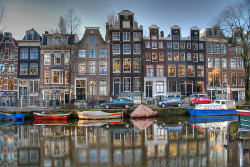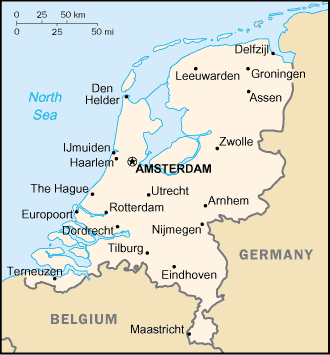The Netherlands is one of the most densely populated and geographically low-lying countries in the world and is famous for its dikes, windmills, wooden shoes, tulips, bicycles and social tolerance. The Netherlands is ranked 7th out of 41 countries in the European region, and its overall score is much higher than the regional average. The Netherlands has an internationally oriented economy, with export and import of goods and services. The Netherlands enjoys high levels of investment freedom, trade freedom, financial freedom, property rights, business freedom, freedom from corruption, and monetary freedom. At this moment the Netherlands is the 16th largest economy of the world.

| Area: | 41,543 sq km |
|---|---|
| Population: | 16,783,092 |
| Religion: | Roman Catholic 30%, Dutch Reformed 11%, Calvinist 6%, other Protestant 3%, Muslim 5.8%, other 2.2%, none 42% |
| Languages: | Dutch (official), Frisian (official) |
| Government type: | constitutional monarchy |
| Capital: | Amsterdam |
| Currency: | Euro |
Background
The Dutch United Provinces declared their independence from Spain in 1579; during the 17th century, they became a leading seafaring and commercial power, with settlements and colonies around the world. After a 20-year French occupation, a Kingdom of the Netherlands was formed in 1815. In 1830 Belgium seceded and formed a separate kingdom. The Netherlands remained neutral in World War I, but suffered invasion and occupation by Germany in World War II. A modern, industrialized nation, the Netherlands is also a large exporter of agricultural products. The country was a founding member of NATO and the EEC (now the EU), and participated in the introduction of the Euro in 1999.
Economy
The Netherlands has a prosperous and open economy, which depends heavily on foreign trade. The economy is noted for stable industrial relations, moderate unemployment and inflation, a sizable current account surplus, and an important role as a European transportation hub. Industrial activity is predominantly in food processing, chemicals, petroleum refining, and electrical machinery. A highly mechanized agricultural sector employs no more than 2% of the labor force but provides large surpluses for the food-processing industry and for exports. The Netherlands, along with 11 of its EU partners, began circulating the Euro currency on 1 January 2002. The country continues to be one of the leading European nations for attracting foreign direct investment.
Geography
The geography of the Netherlands makes Holland one of the most unique countries on Earth. This is due to the fact that much of its land was reclaimed from the sea and is below sea level, it is protected by dikes. The country can be divided into two areas. The low and flat lands in the west and north, including the reclaimed polders and river deltas, make up about half of its surface area and are less than 1 meter above sea level, and much of it is actually below sea level. An extensive range of seawalls and coastal dunes protect the Netherlands from the sea, and levees and dikes along the rivers protect against flooding from rivers. The higher lands with minor hills in the east and south are also mostly flat, only in the extreme south of the country there are some foothills of the Ardennes mountains. This is where Vaalserberg is located, the country’s highest point at 322.7 meters above sea level.

Culture
The Netherlands have had many well-known painters. The 17th century, when the Dutch republic was prosperous, was the age of the “Dutch Masters”, such as Rembrandt van Rijn, Johannes Vermeer, Jan Steen and many others. Famous Dutch painters of the 19th and 20th century were Vincent van Gogh and Piet Mondriaan. The Netherlands is the country of philosophers Erasmus of Rotterdam and Spinoza, and all of Descartes’ major work was done there. The Dutch scientist Christiaan Huygens (1629–1695) discovered Saturn’s moon Titan and invented the pendulum clock. In the Dutch Golden Age, literature flourished as well, with Joost van den Vondel and P.C. Hooft as the two most famous writers. Windmills, tulips and wooden shoes are among the items associated with the Netherlands.
Education
Compulsory education (leerplicht) in the Netherlands starts at the age of five, although in practice, most schools accept children from the age of four. From the age of sixteen there is a partial compulsory education (partiële leerplicht), meaning a pupil must attend some form of education for at least two days a week. Compulsory education ends for pupils age eighteen and up.
Public schools are controlled by local governments. Special schools are controlled by a school board.
In elementary and high schools the students are assessed annually by a team of teachers, who determine whether the pupil has advanced enough to move on to the next grade. If the pupil has not advanced enough he or she may have to retake the year (blijven zitten, English: stay seated); this is an uncommon occurrence. Highly intelligent children are sometimes granted the opportunity to skip an entire year, yet this happens rarely and usually in elementary schools.
Basisonderwijs:
Between the ages of four to twelve, children attend basisschool (elementary school; literally, “basis school”).
Voortgezet Onderwijs:
After attending elementary education, children aged 12 years old attend voortgezet onderwijs (high school; literally “continued education”). Depending on the advice of the elementary school and the score of the Cito test, pupils are assigned to either vmbo, havo or vwo.
Vmbo
The vmbo (voorbereidend middelbaar beroepsonderwijs, literally, “preparatory middle-level vocational education”) education lasts four years, from the age of twelve to sixteen. It combines vocational training with theoretical education in languages, mathematics, history, arts and sciences. Sixty percent of students nationally are enrolled in vmbo. Vmbo itself has four different levels, in each a different mix of practical vocational training and theoretical education is combined.
Havo
The havo (hoger algemeen voortgezet onderwijs, literally, “higher general continued education”) has five grades and is attended from age twelve to seventeen. A havo diploma provides access to the HBO-level (polytechnic) of tertiary education.
Vwo
The vwo (voorbereidend wetenschappelijk onderwijs, literally, “preparatory scientific education”) has six grades and is attended from age twelve to eighteen. A vwo diploma provides access to wo training, although universities may set their own admittance criteria (e.g. based on profile or on certain subjects).
Vavo
Vavo (voortgezet algemeen volwassenen Onderwijs, literally, “prolonged general adult education”) is vmbo, havo or vwo taught for adults.
Vervolgonderwijs:
Mbo
Mbo (middelbaar beroepsonderwijs, literally, “middle-level vocational education”) is oriented towards vocational training. Many pupils with a vmbo-diploma attend mbo. Mbo lasts three to four years. After mbo, pupils can enroll in hbo or enter the job market.
Hbo
With an mbo, havo or vwo diploma, pupils can enroll in hbo (Hoger Beroeps Onderwijs, literally “higher professional education”). It is oriented towards higher learning and professional training, which takes four to six years. The teaching in the hbo is standardized as a result of the Bologna process. After obtaining enough credits (ECTS) pupils will receive a 4 years Bachelor’s degree. They can choose to study longer and obtain a Master’s degree in 2 years.
Wo
With a vwo-diploma or a propedeuse in hbo, pupils can enroll in wo (wetenschappelijk onderwijs, literally “scientific education”). Wo is only taught at a university. It is oriented towards higher learning in the arts or sciences. The teaching in the wo, too, is standardized due to the Bologna process. After obtaining enough credits (ECTS), pupils will receive a 3 years Bachelor of Arts, Bachelor of Science or Bachelor of Laws degree. They can choose to study longer in order to obtain a Master’s degree of different fields. At the moment, there are three variants: Master of Arts, Sciences, and Master of Laws. A theoretical Master requires one year, while practical (e.g. medical) and research Masters require two or three years.
In The Netherlands, grades from 1.0 up to 10.0 are used, with 1 being worst and 10 being best. Generally one decimal place is used and a +/− means a quarter, rounded to either 0.8 or 0.3. Thus, a 6.75 could be written as 7− and count as an 6.8, whereas a 7+ would be a 7.25 and count as an 7.3.
The grade scale with the labels:
- 10 (excellent)
- 9 (very good)
- 8 (good)
- 7 (more than sufficient)
- 6 (sufficient)
- 5 (insufficient)
- 4 (strongly insufficient)
- 3 (very strongly insufficient)
- 2 (bad)
- 1 (very bad)
Depending on the grade, several honors are available: total average of grades 8 with no grade under 7 and finishing in time: cum laude. For an average better than 7, but not meeting the criteria for cum laude, met genoegen (with honor), is sometimes awarded. This honor system is typically only used at universities.
Usually 5.5 and up constitute a pass whereas 5.4 and below constitute a fail. If no decimal places are used, 6 and up is a pass and 5 and below a fail. Sometimes, when no decimal place is used, an additional grade, 6−, is used as “barely passed”. This is what would have been a 5.5 if a decimal place were used.
Converting the numbers of the Dutch grading system into the letters of systems such as those used in the United States and Great Britain, is difficult. It can really only be done if one can compare the frequency distribution of grades in the two systems.
Myanmar Connections
If you have additional information or suggestions for this section, please contact myanmarstudyabroad@gmail.com

